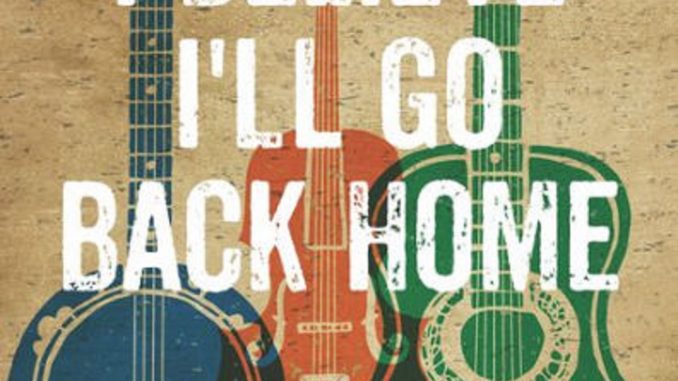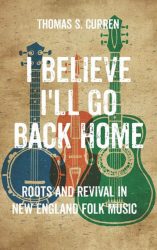
The New England folk revival was not just about music but the real soul of America.
 The American folk revival of the late ‘50s and ‘60s had a massive influence on the mid-sixties music explosion, and its influence extended into politics through its close association with the civil rights movement. Most fans of what has become americana will have at least an awareness of the folk revival and some if not all of the leading lights. What may not be so well known is the depth of the influence New England had on the folk revival and this is where Thomas S. Curren’s ‘I Believe I’ll Go Back Home’ comes in. Thomas S. Curren is chairman of the board of Folk New England and has used interviews with the key players of the folk scene, and the key players are the key players at the time, not simply those artists who established a reputation beyond the New England folk scene. This ensures the level of detail is unbelievably rich, and Curren has captured real history for future generations, as well as fans of the music, artists, and period. Curren also provides a detailed context for the New England folk scene by showing how the history of the United States, as filtered through New England, influenced the development of the scene and helps explain the close links with the civil rights movement.
The American folk revival of the late ‘50s and ‘60s had a massive influence on the mid-sixties music explosion, and its influence extended into politics through its close association with the civil rights movement. Most fans of what has become americana will have at least an awareness of the folk revival and some if not all of the leading lights. What may not be so well known is the depth of the influence New England had on the folk revival and this is where Thomas S. Curren’s ‘I Believe I’ll Go Back Home’ comes in. Thomas S. Curren is chairman of the board of Folk New England and has used interviews with the key players of the folk scene, and the key players are the key players at the time, not simply those artists who established a reputation beyond the New England folk scene. This ensures the level of detail is unbelievably rich, and Curren has captured real history for future generations, as well as fans of the music, artists, and period. Curren also provides a detailed context for the New England folk scene by showing how the history of the United States, as filtered through New England, influenced the development of the scene and helps explain the close links with the civil rights movement.
Before any readers of this review get the idea that ‘I Believe I’ll Go Back Home’ is some scholarly great tome, rest assured that Curren’s text is very readable, and at just over three hundred pages it shouldn’t tax even readers with only a cursory interest in the subject. The book’s structure ensures that Curran’s ideas and arguments are very clear, and even readers who think they have a well-informed view of the New England folk revival will find plenty to stimulate their thought processes, and any newbies may become open-mouthed as Curran clearly demonstrates the influence the folk revival had on subsequent generations of musicians, most notably on the San Francisco music explosion of the ‘60s. Curran gives a clear argument with evidence that it was the original New England Yankee ideals of freedom and society that inspired the financially independent students of the ‘50s and ‘60s, faced with potential nuclear oblivion, to look back and take inspiration from a simpler and more honest time. This view influenced the politics and the music of the time, remembering that the groundbreaking music recorded at the dawn of recording history was still accessible through old 78s, and still living artists from the ‘20s and ‘30s were able to play to their newfound audience, and the music hinted at an idealised pre-industrial age.
Some things just jumped out of the pages and brought new insight to this particular reader. One was that the Irish, Scottish, and English ballads that are the bedrock of Appalachian music, and therefore the music of the American South and subsequently americana, traveled there from New England, and New England maintained its own folk traditions based on that of the first settlers of America. While that is perfectly logical and even obvious, it is easy to forget New England’s role in the development of America’s own musical forms and look straight to the South. The Broadside was a free publication that covered the coffeehouses, acts, and performances of Boston and Cambridge when it was launched in 1962. It subsequently covered all of New England and included political articles, and it set the template for the underground press of the ‘60s. Curren lists the recordings associated with the movement from 1948-1968 and just a cursory glance down the list gives a flavour of the artists who owed their career to the New England folk revival, including Joan Baez, Bonnie Dobson, Pete Seegar, Charles River Boys, Jim Kweskin and the Jug Band, Tom Rush, Keith & Rooney, Eric Von Schmidt, Holy Modal Rounders, Buffy Sainte-Marie, Mimi and Richard Farina, Taj Mahal, Geoff and Maria Muldaur, and many more.
Whatever the socio-geographical and political influences bearing down on the music, the New England folk revival wouldn’t have ignited without Boston and Cambridge students, with their student finances, who provided the audience, and some of the performers, for the emerging music scene. In fact, Curren makes it very clear that one college dropout had a major influence on driving the popularity of New England folk music, one Joan Baez. This far removed from the ‘60s, it isn’t always obvious just how influential Jim Kweskin & the Jug Band, which included Geoff and Maria Muldaur, Bill Keith, and Fritz Richmond, were with their mix of folk, blues, jazz influences, and their take on pre-WWII music. They were a major influence on the emerging music scene in San Francisco, and a particular influence on the Grateful Dead’s Jerry Garcia and their relative success helped popularise jug band music across America, and Curran gives the Jug Band full credit for their proselytizing. The Beatles also feature in ‘I Believe I’ll Go Back Home’ and Curran describes how, while the older folkies may have been dismissive of this new music, the young folkies found much to enjoy and they heard the country harmonies of the Everly Broths and the sounds of black girl groups in the Beatles music. This exposure to the early Beatles music helped the young folkies power the rock music explosion of the mid to late-60s, and the ultimate death of the folk revival itself. Oh, and we shouldn’t forget that the Woodstock music scene of Dylan and the Band was simply another outcrop of the New England folk revival.
In the final chapter Curren reflects on the events of sixty years ago and the current state of America. He draws out the fact that one of the main reasons that the New England folk revival was so successful and influenced the whole of America, and subsequently the world, was that it sprung from ideas rather than any practical necessity. It brought into the mid-twentieth century the original ideals of freedom and justice that had inspired the first Americans, and while it couldn’t possibly deliver on all of its ideals, it did make a difference. The current fractious state of American society and politics is crying out for a confirmation of what true American values are. It is beyond doubt that what is now called roots music has the power to invoke a bygone age and thereby help renew ideals and the human spirit.
What makes ‘I Believe I’ll Go Back Home’ such a worthwhile read for anyone with an interest in the New England folk revival is the fact that Thomas S. Curren brings local knowledge and a local perspective plus fifty years of research to bear on the contents. When you add to this the fact that it is written in a very readable style, with a structure that supports the various themes and ideas, you get a very good book on the New England folk revival. So good in fact, that it should become a key reference book for future generations as well as current music fans.


